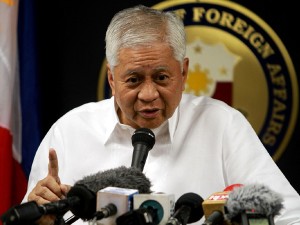MANILA, Philippines – Expect a “greater number” of United States warships to visit the country as Washington increases its military presence in Asia in the coming years, according to Foreign Secretary Albert del Rosario.
In a text message to the INQUIRER, Del Rosario on Sunday said: “Yes, we can anticipate a greater number
of port calls (by US Navy vessels).”
Stressing they are covered by the 1998 Visiting Forces Agreement (VFA) between Manila and Washington, the Department of Foreign Affairs has repeatedly defended the ship visits against charges by militant groups that they are a “showcase of the one-sided pact” favoring the US.
The goodwill visits of American warships are “part of the routine port calls that friendly navies make,” said the DFA, as it also asserted the VFA was indispensable to the nation’s security.
Asked to comment on Washington’s new military strategy to reposition its Navy fleet in the region, Del Rosario said “the increased presence of the US is consistent with its strategic guidance for the Asia-Pacific.”
US Defense Secretary Leon Panetta the other day announced the US will move the majority of its warships to the region in the coming years.
Speaking at an annual security forum in Singapore, Panetta, however, said the shift in US focus to Asia was not designed to contain China’s emergence as a global power.
He acknowledged differences between the world’s two largest economies on a range of issues, including the West Philippine Sea (South China Sea), noting “we’re not naive about the relationship and neither is China.”
Panetta’s comments came at the start of a seven-day visit to Asia to explain to allies the practical meaning of the US military strategy unveiled in January that calls for rebalancing American forces to focus in the region.
The trip comes at a time of renewed tensions over competing territorial claims in the West Philippine Sea with the Philippines, a major US ally, and China in a standoff over the Scarborough Shoal, which Manila calls Bajo de Masinloc and Panatag Shoal. On the other hand, Beijing refers to the rock formation as Huangyan Island.
The boost in American ship presence could increase tensions with China, where leaders have said they are unhappy with any larger US presence in the Asia-Pacific, warned the Associated Press.
Last month, the US Embassy in Manila said more US Navy vessels – including the hospital ship USNS Mercy – would visit the Philippines this year.
Sometime this month, the San Diego, California-based vessel “will provide medical, dental and veterinary services to Filipinos on the islands of Samar, Basilan and Sulu,” said the embassy in a report posted on its website.
The USNS Mercy, originally built as an oil tanker in 1976, treated over 62,000 patients during its maiden port calls in the Philippines and several South Pacific states after its Nov. 8, 1986 commissioning by the US Navy.
The 894-ft. hospital ship has four operating rooms, four ICU and isolation wards and over 80 beds. It also offers pharmaceutical, radiological, physical therapy, burn care and optometry services, among others.
Last month, the Virginia-class attack submarine USS North Carolina, one of the stealthiest and most technologically-advanced nuclear-powered submarines in the world, arrived at Subic Bay for a brief port call.
Homeported in Pearl Harbor, Hawaii, the 350-feet long submarine with a crew of 133 came amid tensions between the Philippines and China over the Scarborough Shoal.
Last year, among the American warships that sailed into Philippine waters was the nuclear-powered aircraft carrier USS Carl Vinson, the same vessels that reportedly buried Osama bin Laden in the North Arabian Sea after the al-Qaida chief was killed during a raid by US commandos on his Pakistan hideout in early May.
The Carl Vinson, which has a speed of over 30 knots and a displacement of 101,300 tons, was escorted by the guided missile cruisers USS Bunker Hill and USS Shiloh and the destroyed USS Gridley. The four warships were manned by over 6,000 sailors.
The US embassy had cited the VFA for, among others, making possible the visit of the aircraft carrier.
Raul Hernandez, the DFA spokesperson, earlier told the INQUIRER “port calls by visiting US forces help us identify our strengths, as well as the gaps in our seaport systems that need to be given development priority.”
He explained “the Philippines and the US have mutually agreed to conduct more activities and exercises to strengthen their respective capacities to respond to humanitarian and natural disasters.”
“Furthermore, with our nation’s desire to improve our maritime domain awareness and security, we have asked our ally, the US, to assist us in this regard by training our military personnel and through professional exchanges,” Hernandez added.
On Sunday, the militant group Bagong Alyansang Makabayan (Bayan) said the US game plan is “consistent with its earlier thrust of rebalancing its troops towards Asia.”
“The country would be a vital transit point and outpost for US warships. Our ports would be used to service the US Navy, much like the time when there was a military base in Subic,” said Bayan secretary general Renato Reyes Jr.
Reyes also said, “we get two old ships and the US gets to use the entire country as a docking station and naval point. And under the VFA, we have no way of knowing if these ships carry nuclear weapons since we can’t inspect them, and the US will neither confirm nor deny.”
He warned that “increased US presence may be seen by China as a provocation and may complicate issues.”


